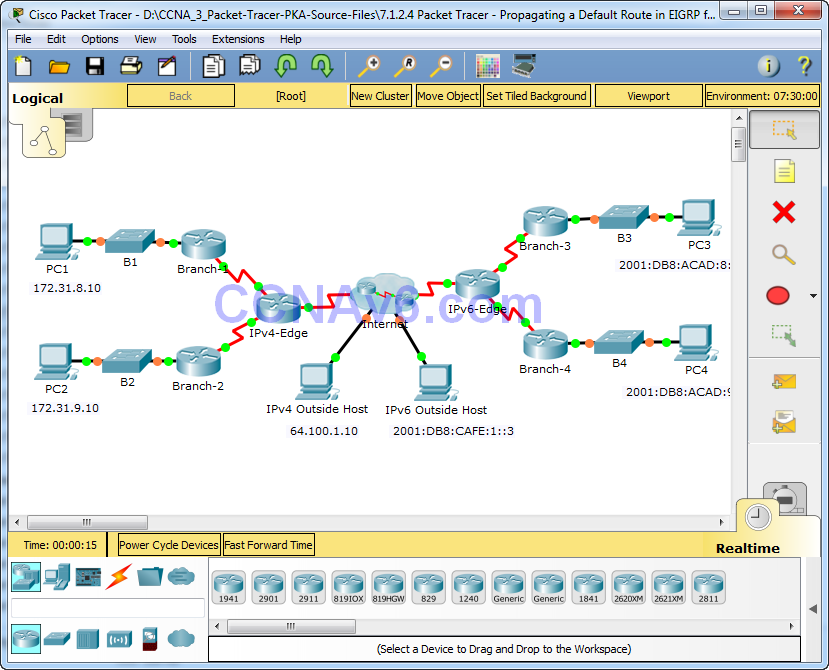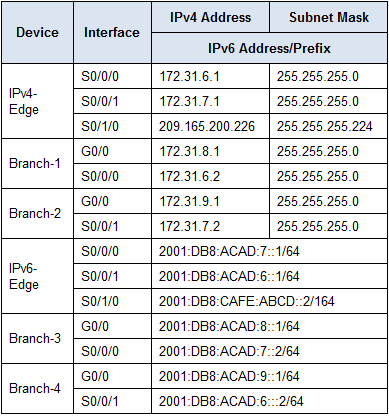Packet Tracer – Propagating a Default Route in EIGRP for IPv4 and IPv6 (Instructor Version)
Instructor Note: Red font color or Gray highlights indicate text that appears in the instructor copy only.
Topology

Addressing Table

Objectives
Part 1: Propagate an IPv4 Default Route
Part 2: Propagate an IPv6 Default Route
Part 3: Verify Connectivity to Outside Hosts
Scenario
In this activity, you will configure and propagate a default route in EIGRP for IPv4 and IPv6 networks. EIGRP is already configured. However, you are required to configure an IPv4 and an IPv6 default route. Then, you will configure the EIGRP routing process to propagate the default route to downstream EIGRP neighbors. Finally, you will verify the default routes by pinging hosts outside the EIGRP routing domain.
Part 1: Propagate a Default Route in EIGRP for IPv4
Step 1: Verify EIGRP configuration on each IPv4 enabled router.
Display the routing table of each IPv4 enabled router and verify that all IPv4 routes are visible.
Step 2: Configure an IPv4 default route.
Configure a directly connected IPv4 default route on IPv4-Edge.
IPv4-Edge(config)# ip route 0.0.0.0 0.0.0.0 Serial0/1/0
Step 3: Propagate the default route in EIGRP.
Configure the EIGRP routing process to propagate the default route.
IPv4-Edge(config)# router eigrp 1 IPv4-Edge(config-router)# redistribute static
Step 4: Verify IPv4 default route is propagating.
Display the routing tables for Branch-1 and Branch-2 to verify the default route is now installed.
Branch-1# show ip route <output omitted> D*EX 0.0.0.0/0 [170/7289856] via 172.31.6.1, 00:01:24, Serial0/0/0 Branch-2# show ip route <output omitted> D*EX 0.0.0.0/0 [170/7289856] via 172.31.7.1, 00:01:45, Serial0/0/1
Part 2: Propagate a Default Route in EIGRP for IPv6
Step 1: Verify EIGRP configuration on each IPv6 enabled router.
Display the routing table of each IPv6 enabled router and verify that all IPv6 routes are visible.
Step 2: Configure an IPv6 default route.
Configure a directly connected IPv6 default route on IPv6-Edge.
IPv6-Edge(config)# ipv6 route ::/0 Serial0/1/0
Step 3: Propagate the default route in EIGRP.
Configure the EIGRP routing process to propagate the default route.
IPv6-Edge(config)# ipv6 router eigrp 1 IPv6-Edge(config-rtr)# redistribute static
Step 4: Verify IPv6 default route is propagating.
Display the routing tables for Branch-3 and Branch-4 to verify the default route is now installed.
Branch-3> en Branch-3# show ipv6 route <output omitted> EX ::/0 [170/7289856] via FE80::1, Serial0/0/0 Branch-4# show ipv6 route <output omitted> EX ::/0 [170/7289856] via FE80::1, Serial0/0/1
Part 3: Verify Connectivity to Outside Hosts
PC1 and PC2 should now be able to ping IPv4 Outside Host.
PC3 and PC4 should now be able to ping IPv6 Outside Host.
